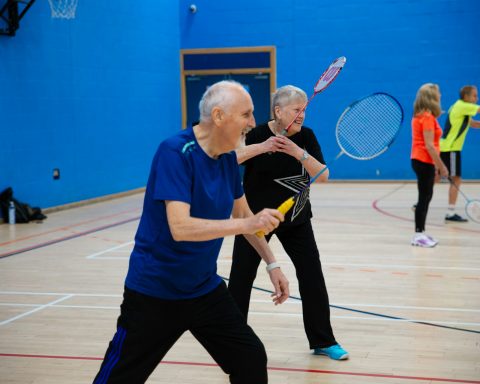 Richard Armitage is a GP and Honorary Assistant Professor at the University of Nottingham’s Academic Unit of Population and Lifespan Sciences. He is on twitter: @drricharmitage
Richard Armitage is a GP and Honorary Assistant Professor at the University of Nottingham’s Academic Unit of Population and Lifespan Sciences. He is on twitter: @drricharmitage
On a monthly basis, NHS Digital publishes its official statistics regarding appointments in general practice. These figures reflect all general practice activity in England, and include total monthly and granular day-by-day data pertaining to, for example, the total number of appointments made; the number of appointments attended and DNA’d; the time between the booking date and the appointment date; whether the appointment was with a GP, a nurse, or a different member of staff; the setting of the appointment (for example, general practice, Primary Care Network, and/or Extended Access Provision); and the mode of the appointment (face-to-face, home visit, and/or telephone or video/online).
Examining the latest instalment of these statistics reveals a subtle yet undeniable trend in one of these metrics — that of the appointment mode, specifically the activity in video/online appointments. Data from November 2017 (earliest available data) to September 2023 (most recent available data at the time of writing) inclusive were collected from the NHS Digital appointments in general practice series.1 The following lines, charts, and observations are derived from these data.
The total number of monthly appointments between November 2017 and September 2023 is shown in Figure 1. During this period, the total number of monthly appointments gradually trended upwards, as depicted by the chart’s line of best fit (this is despite the brief but substantial reduction in appointments as the first COVID-19 national lockdown was introduced to the UK).2
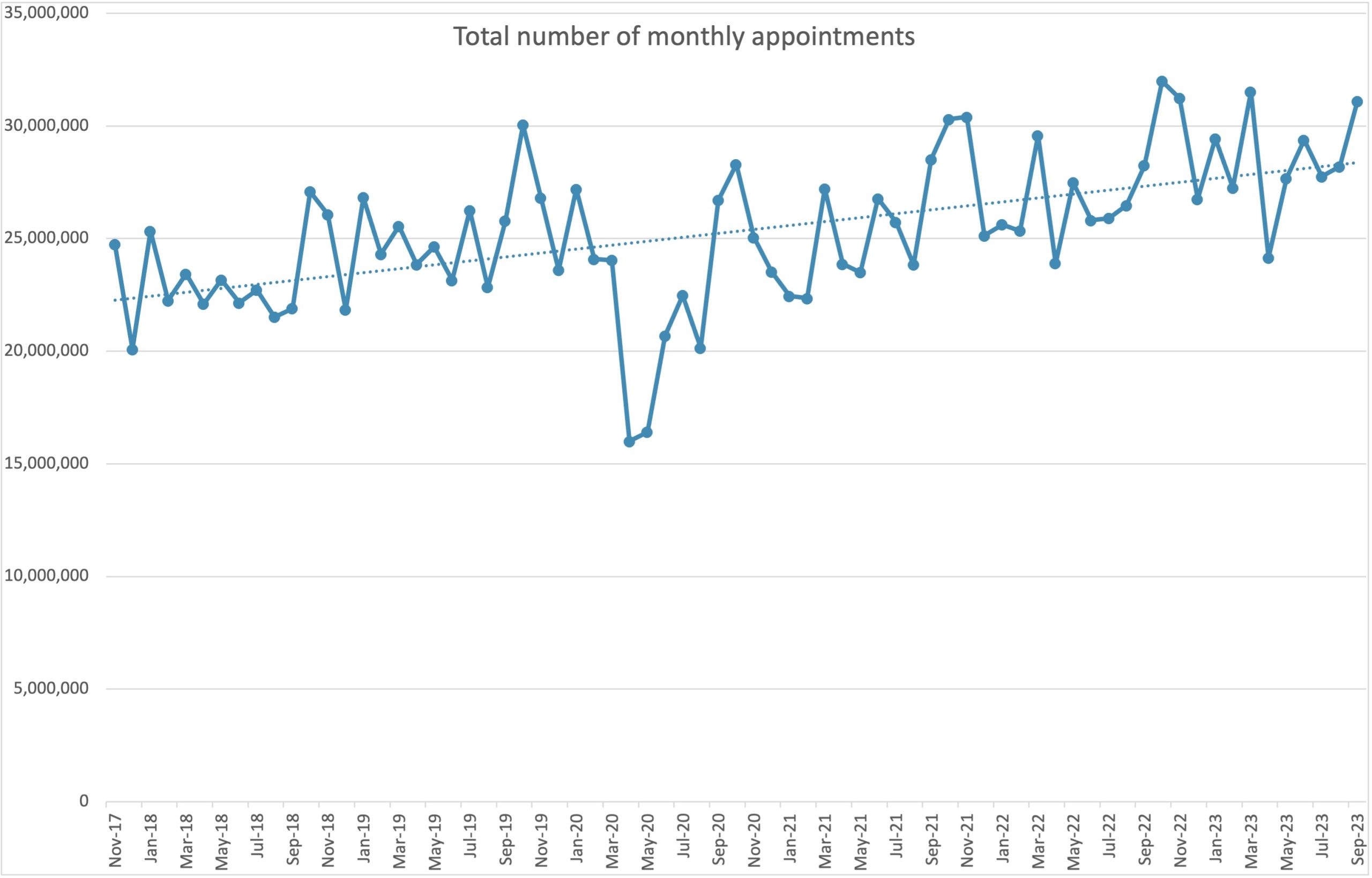
The total number of monthly appointments by appointment mode between November 2017 and September 2023 is shown in Figure 2. The number of monthly face-to-face appointments plummeted, while the number of telephone appointments skyrocketed, in early 2020 as the country entered the first COVID-19 national lockdown. By August 2022, the number of monthly face-to-face appointments reached its pre-pandemic baseline. Simultaneously, the number of monthly telephone appointments had fallen but had not returned to its pre-pandemic baseline, and a new post-pandemic baseline — which is substantially higher than that prior to COVID-19 — was established by mid-2022.
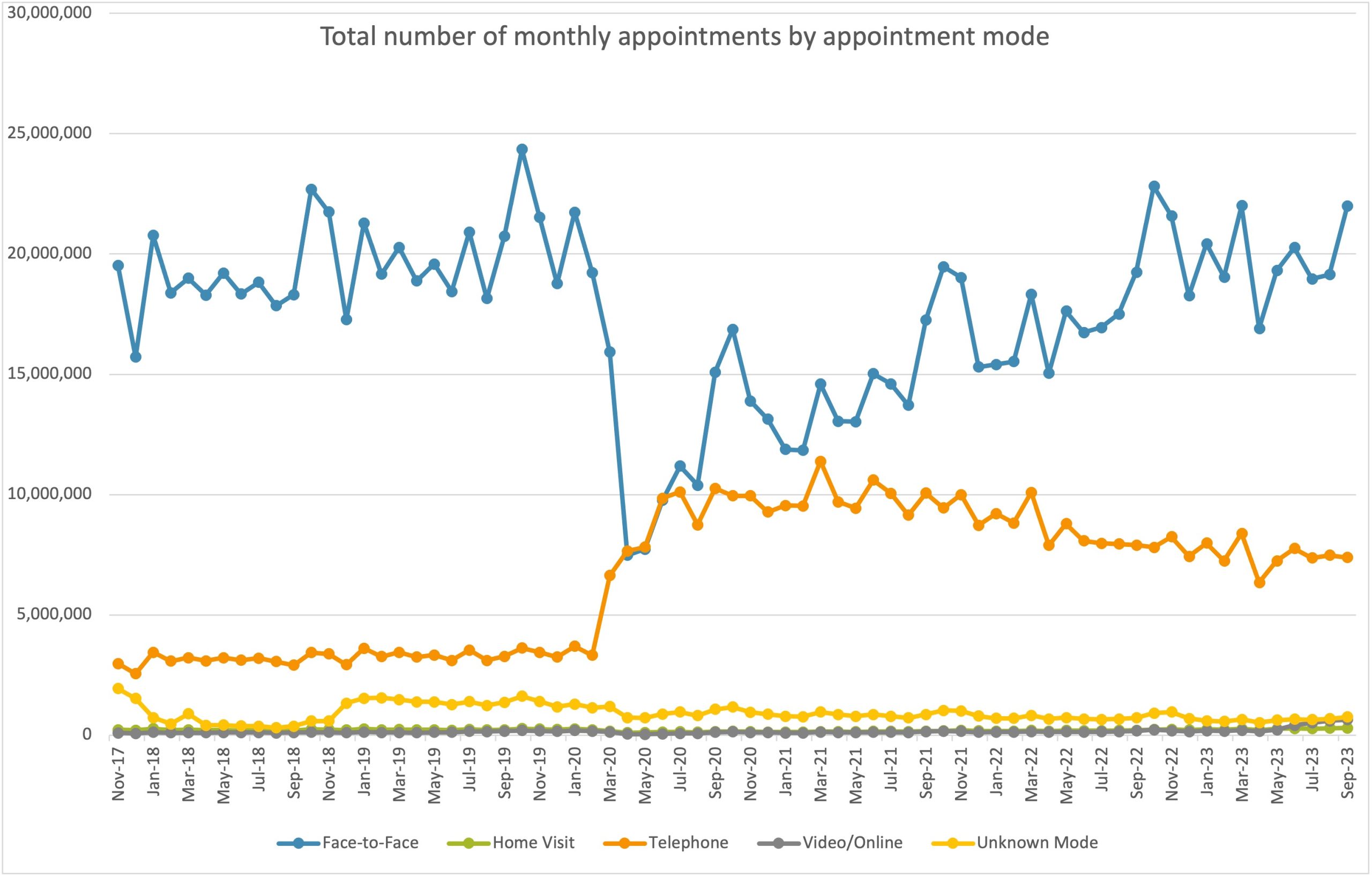
To adjust for the increasing total number of appointments between November 2017 and September 2023, the appointment modes as a proportion of total appointments during this period is shown in Figure 3. In the pre-pandemic phase, face-to-face appointments constituted about 80% of total appointments, while about 14% of appointments took place via telephone. As soon as the first COVID-19 national lockdown was instigated, these modes changed rapidly and dramatically such that each constituted about 48% of total appointments. Since then, both modes have trended towards their pre-pandemic baselines at a comparable rate, but neither have yet reached their pre-pandemic baselines. Meanwhile, over summer 2023, movement appears to be occurring in the trend of video/online appointments.
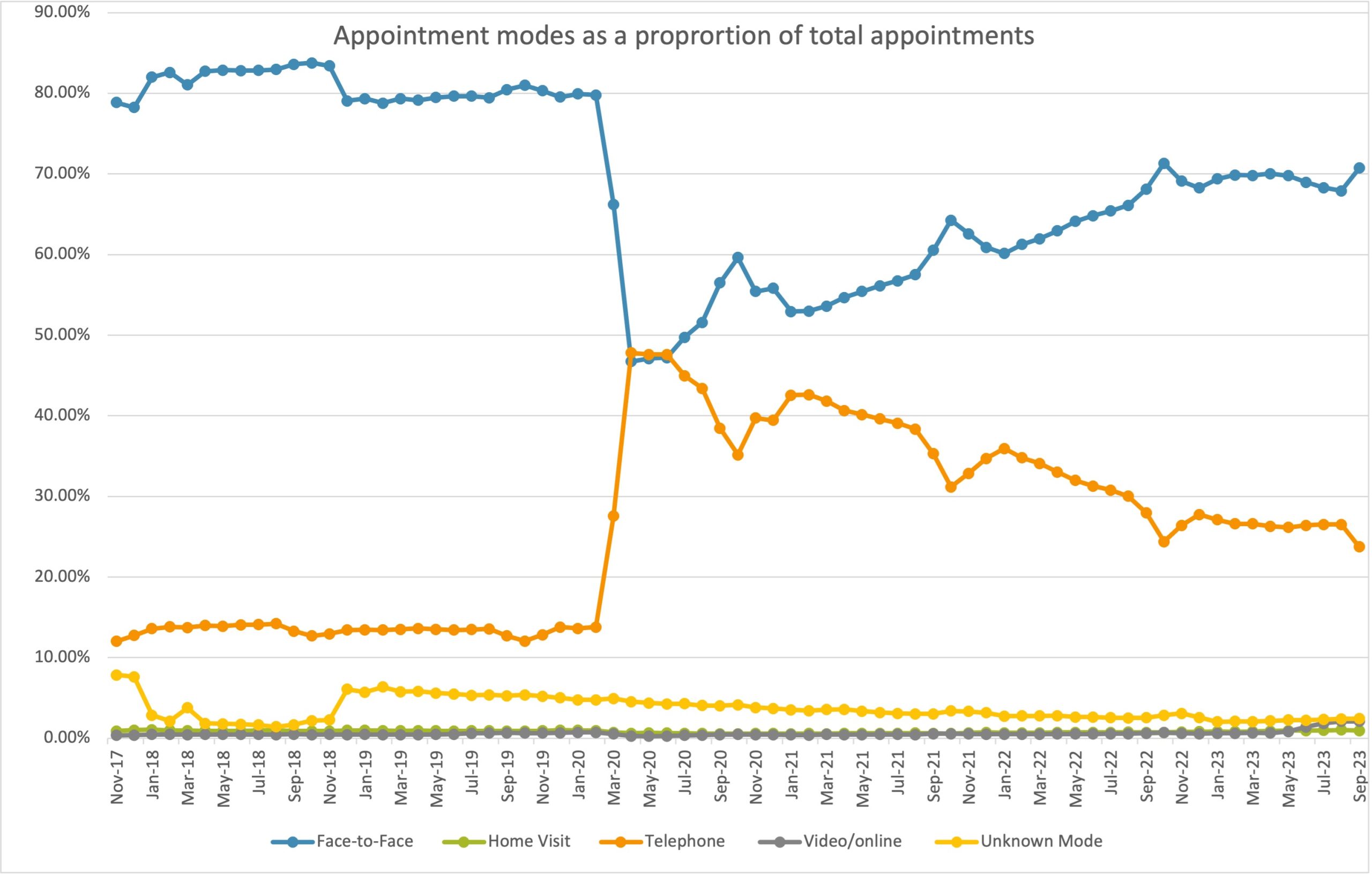
About 0.5% of appointments took place via video/online until spring 2023 (Figure 4). This figure suddenly increased four-fold between May 2023 and August 2023 to constitute over 2% of total monthly appointments. While the absolute number of appointments conducted via video/online remains comparatively low (about 650 000 of 31 million total appointments), the rate of increased adoption of this mode is substantial.
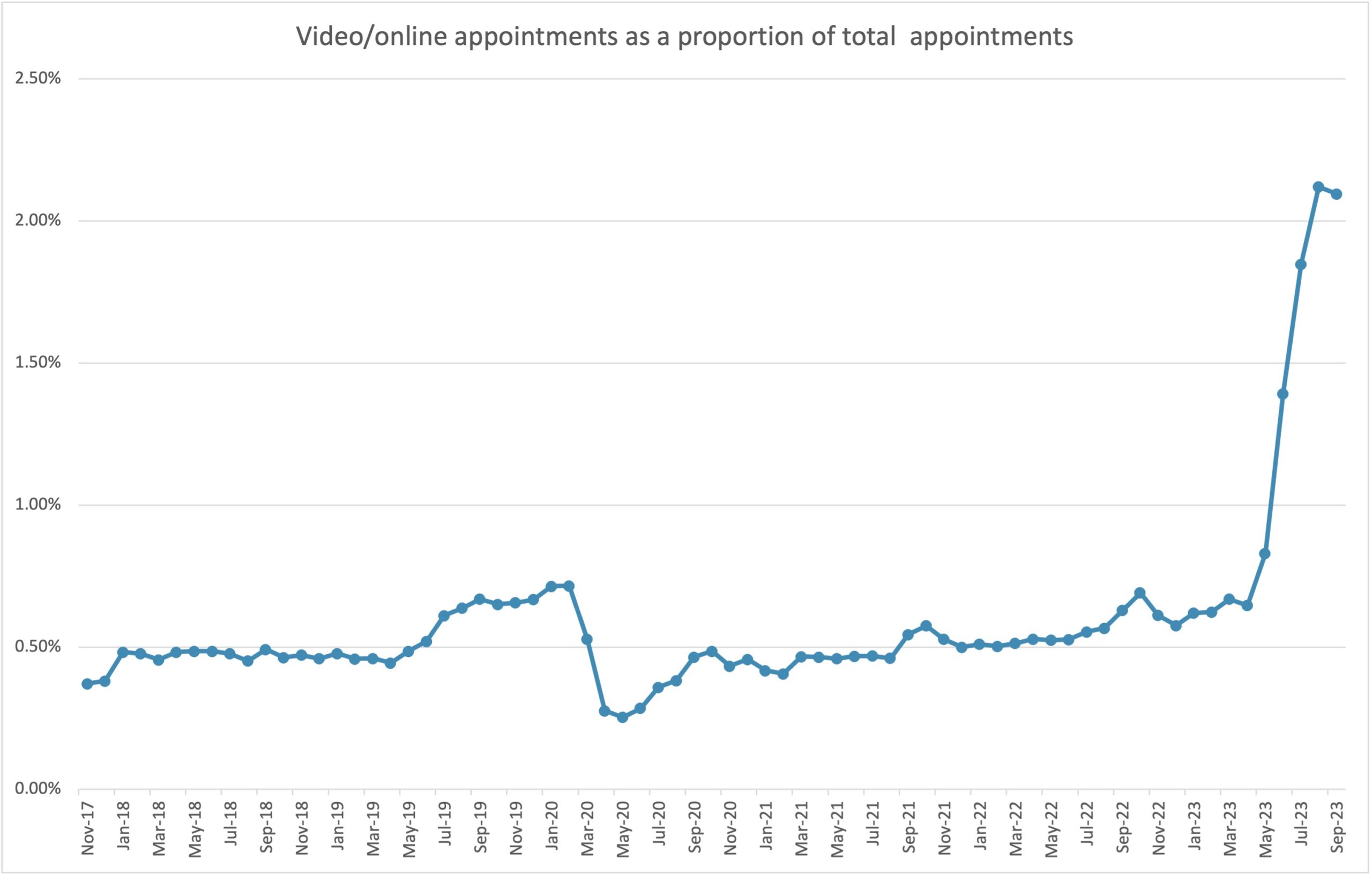
There is no obvious explanation for this sudden and considerable increase in the uptake of video/online appointments. For these consultations to take place, patients require a smartphone, tablet, or computer that allows video calling, and an internet connection.3,4 The most recent Office for National Statistics data pertain to January–February 2020 and show that 96% of households in Great Britain had internet access,5 suggesting that a sudden increase in the already near-ubiquitous coverage of internet access is unlikely to explain this trend.
A 2022 qualitative study acknowledged that, at the time, <1% of UK general practice consultations took place via video/online appointments, and found that primary care patients and staff regarded the relative advantage of video ‘as minimal for most of the caseload of general practice, since many presenting problems could be sorted adequately and safely by telephone and in-person assessment was considered necessary for the remainder.’ 6
The study also found that patients sometimes considered video appointments as convenient, yet no seasonal uptake in this mode (such as over the summer period to account for summer holidays) was found by NHS Digital data in previous years, implying the recent trend constitutes a real change that cannot be explained by seasonal variations. The study also found that video ‘sometimes added value for out-of-hours and nursing home consultations and statutory functions (for example, death certification)’, yet there is no obvious reason why these kinds of activity would dramatically increase and induce a corresponding uptick in video appointments over this period.
With regard to technological advancements, NHS Digital claims that ‘online consultation is now available within the NHS App’,7 yet these consultations do not amount to video/online (or any other mode of) appointments. This new facility allows patients to submit an online form with information about their problem, which the practice then reviews and decides how to manage, which might lead to ‘setting up a telephone or video consultation or a face-to-face appointment with a professional from the practice.’ Changes in the NHS App therefore do not appear to explain the recent increased adoption of video/online appointments.
It may, therefore, simply be the case that patients are becoming more comfortable with, and therefore increasingly accepting of, video/online appointments. Why this rise in popularity has taken place so recently and suddenly, however — if indeed it has done — is unclear. Further qualitative research akin to that from 2022 is needed to explain this. Regardless of the reasons behind this trend, however, the acceptability and popularity of digital health, specifically remote consultations, appears to be growing. Should it continue, GPs would need to adapt their practice to accommodate the evolving patient preferences with regard video/online appointments.
References
1. NHS Digital. Appointments in general practice. 2023. https://digital.nhs.uk/data-and-information/publications/statistical/appointments-in-general-practice (accessed 12 Dec 2023).
2. Institute for Government. Timeline of UK government coronavirus lockdowns and measures, March 2020 to December 2021. https://www.instituteforgovernment.org.uk/sites/default/files/timeline-coronavirus-lockdown-december-2021.pdf (accessed 12 Dec 2023).
3. NHS. Video consultation. 2023. https://www.nhs.uk/nhs-services/gps/video-consultations (accessed 12 Dec 2023).
4. NHS England. Frequently asked questions about video consultations. https://www.england.nhs.uk/outpatient-transformation-programme/video-consultations-in-secondary-care/frequently-asked-questions (accessed 12 Dec 2023).
5. Office for National Statistics. Internet access — households and individuals, Great Britain: 2020. 2020. https://www.ons.gov.uk/peoplepopulationandcommunity/householdcharacteristics/homeinternetandsocialmediausage/bulletins/internetaccesshouseholdsandindividuals/2020 (accessed 12 Dec 2023).
6. Greenhalgh T, Ladds E, Hughes G, et al. Why do GPs rarely do video consultations? qualitative study in UK general practice. Br J Gen Pract 2022; DOI: https://doi.org/10.3399/BJGP.2021.0658.
7. NHS Digital. Online consultations. 2023. https://digital.nhs.uk/services/nhs-app/nhs-app-guidance-for-gp-practices/guidance-on-nhs-app-features/online-consultations (accessed 12 Dec 2023).
Featured photo by Christian Wiediger on Unsplash.


